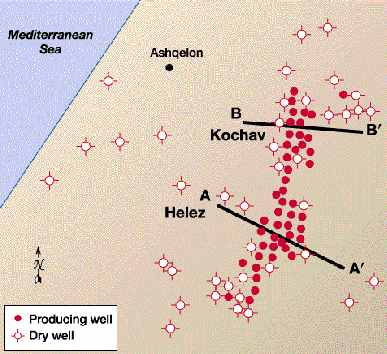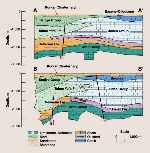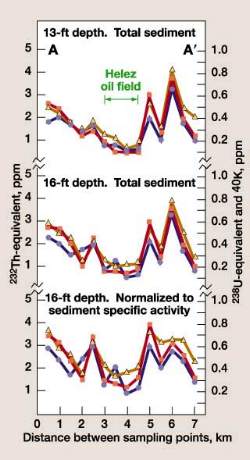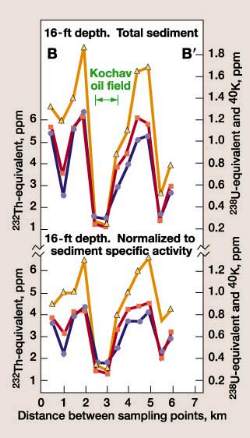Careful analysis reveals root cause of gamma-ray anomalies
Careful analysis reveals root cause of gamma-ray anomaliesRadiometric surveys in exploration have shown anomalies over many oil fields. Absence as to an underlying cause has led to debate, since until now, specific radio-element constituents were not measuredN. E. Yanaki and D. Ashery, School of Physics and Astronomy; and J. Kronfeld, Geophysics and Planetary Sciences, Tel-Aviv University, Ramat-Aviv, Israel
Analysis of 12- and 16-ft-deep soil samples show that total gamma-ray intensity anomaly over Helez and Kochav oil fields in Israel is due to depletion in all three radionuclides (K-40, Th-232 and U-238). The surface location of the radiometric anomalies above petroleum reservoirs at depth suggests a genetic connection. It is further proposed that soil radioactivity is not the result of vertical radionuclide transport from the reservoir, rather, that migrating hydrocarbons interact and degrade clays and other soil minerals, which then release large cations that substitute for each other diadochously. Introduction The search for pathfinder techniques by which surface phenomena are used to indicate subsurface petroleum reservoirs has been ongoing for some time. The use of radiometric surveys is one such unconventional method. Russian researchers in particular have invested considerable effort in evaluating this method. Radiometric, low-level anomalies have been claimed to exist over oil fields in the Lower Volga region, West Turkmenia, Azerbaijan and the Caspian Sea.1 These studies investigated total gamma-ray flux and not the specific radio-element constituents, which has led to debate as to whether a genetic relationship exists between the underlying oil and gas and low gamma-ray values. Some researchers have claimed that such a relationship exists,2,3 while others considered the relationship to be incidental and that the anomalies relate to tectonic features or changes in bedrock or soil composition.1,4,5 Lack of an adequate theory to establish a connection between the petroleum reservoir and surface anomalies led Hunt to conclude that pathfinder techniques are not valid prospecting tools, except in those areas where faults and fractures exist to allow upward migration of low-level seepages.6 Despite lack of a proven theoretical basis, Weart and Heimberg concluded that radiometrics, based on surface radioactivity, could have greater than 50% success in forecasting hydrocarbon potential at depth.7 However, the concept of hydrocarbon leakage through supposedly impermeable traps must be accepted. More-recent studies have shown good results in correlating surface radiation to subsurface hydrocarbon accumulations.8,9,10,11 Thus, among proponents of the method, the debate has shifted to the mode by which the negative anomaly is established. Among the proposed hypotheses is one that the anomaly relates to a flux of radionuclides rising from the reservoir. Another holds that the anomalies result from diagenetic alteration of radio-element-bearing minerals at the surface caused by an ascending hydrocarbon flux. Until recently, a major limitation to testing the different points of view is that most surveys study the total gamma-ray flux. This does not discriminate individual contributions of gamma-emitting elements. Some years ago, Mazor noted the presence of a halo-type anomaly (i.e., relatively low levels surrounded by higher levels) over the Helez oil field in Israel.12 He used a small, non-discriminating, uncalibrated gamma-ray spectrometer to measure the total gamma-ray field. He recommended that a further survey be conducted to study the specific nuclides involved. The present study was carried out for this purpose. Independently, another group studied the same area using integrated thermoluminescence detectors.13 Their study emphatically claimed correlation of surface anomalies to petroleum traps at depth. However, the study, like others, monitored only the total gamma-ray field and did not identify the contribution of specific elements. This study presents results of the gamma-ray investigation, with particular attention paid to concentrations of the specific radionuclides in the overlying sediment. This leads to a different interpretation of the processes involved. Sampling And Methods The Helez and Kochav oil fields are located some 6 mi from the Mediterranean Sea and 30 mi south of Tel-Aviv, Fig. 1. The petroleum reservoirs are found in traps roughly 4,000 ft deep. Representative geological sections for Helez and the Kochav fields are shown in Fig. 2. Fourteen drill holes, spaced 0.3 mi apart, were made across Helez and 12 across Kochav field. Two-kg samples were collected from the Kurkar sediments of Quaternary age (carbonate-cemented dune sands and related rocks and sediments) at 13- and 16-ft depths. These were oven dried to 105°C and then divided into representative sample splits.
One 200-g split was placed into a cylindrical plastic box and sealed to ensure closure with respect to radon. After one month, each sample was counted for a day using a very low-background, high-sensitivity, gamma-ray spectrometer with a 120-cm3 Ge(Li) crystal detector. Uranium (or the equivalent-uranium) was determined by measuring its gamma-emitting daughters, Pb-214 and Bi-214. Gamma-emitting daughters in the Th-232 series (Ac-228, Bi-212 and Bi-214) were used to determine equivalent-thorium. K-40 was determined by measuring its single, characteristic-energy peak. Another split sample (700 g) was sent to the Israel Standards Institute for grain-size analysis. After separating sand, silt and clay sizes by wet-sieving, each size fraction from nine sediment samples was analyzed individually by gamma-ray spectrometry. The counting period for each fraction was two days. Results Results of gamma-ray measurements for the total sediment overlying Helez and Kochav oil fields are presented graphically in Figs. 3 and 4, respectively. The statistical counting error is ±5% at the 1s confidence level. Grain-size analyses indicated that the samples were uniform, with 50 – 60% sand, »30% clay and the remainder silt-sized material.
All the radionuclides strongly correlated with the clay fraction (r = +0.85 to +0.90); the clay-size fraction yields about 3.5 times more radioactivity (for each of the nuclides) than a similar quantity of sand and 1.75 more radioactivity than the silt. Average gamma-ray activity for the three size fractions was used in conjunction with grain-size analyses to normalize all sediment samples for each radio-metal to a uniform percent-sand composition. There is a very small difference between normalized and non-normalized gamma-ray traverses (Figs. 3 and 4), with congruent geochemical behavior among the three radio-elements. Conclusions A negative gamma-ray anomaly was found over both Helez and Kochav oil fields due to a depletion in K, U and Th. The constant relative proportions of these three elements in all samples give a clue to the process that affected their surface abundance while relating to hydrocarbons in the subsurface. Since their aqueous chemistries are quite different, it is difficult to account for such a uniform depletion – with concomitant flanking highs – by a process of vertical aqueous transfer of daughter nuclides; especially from a reservoir in which redox changes have led, primarily, to uranium accumulation. Nor can continuous gaseous-transfer processes, requiring Rn daughters of Th and U, be responsible for the surface elemental distribution (K has no gaseous precursor). However, these elements do tend to behave similarly when entering the crystal structure of rock-forming minerals (and when adsorbed onto clay surfaces) mainly due to similarity in the ionic radius of these large cations. It thus appears that an upward flux of radionuclides leaking from the reservoir does not explain the observed features. Rather, it may be the hydrocarbon flux itself, which can be corrosive,14 that leads to mineral alteration in the overlying sedimentary rock and the release of associated cations. These would tend to migrate laterally, away from the altered area, and become immobile at the periphery by adsorption on clays. This interpretation is different from that presented by Siegal, et al., for explaining the radiometric activity over Helez and Kochav oil fields.13 Though techniques that measure the total ambient field may be useful in
radiometric reconnaissance, they do not give adequate information on the behavior of the individual nuclides
involved. An understanding of the geochemical behavior is needed to evaluate hypotheses regarding the
underlying processes that affect the radio-metal distribution in the near surface. In this way, a basis can be
established for a genetic relationship between low gamma-ray surface values and underlying oil and gas
reservoirs.
Acknowledgment
Literature Cited
|






